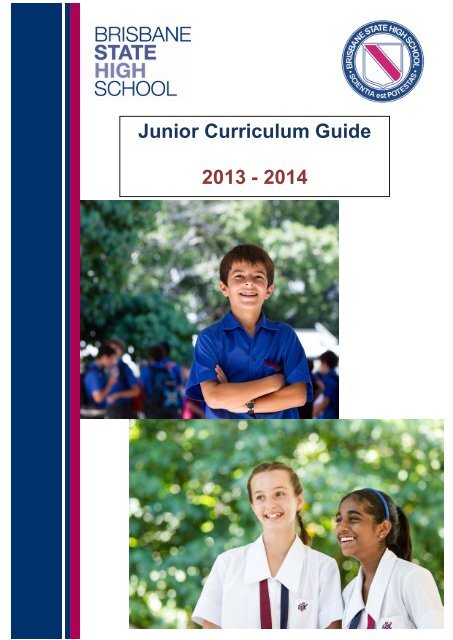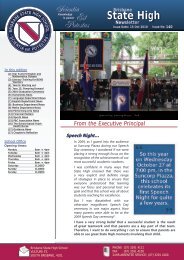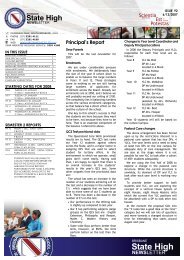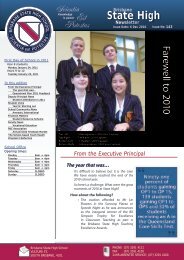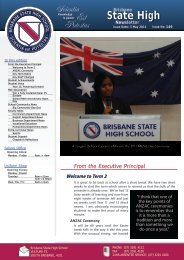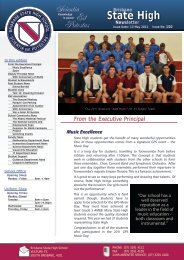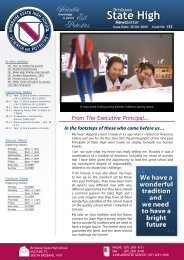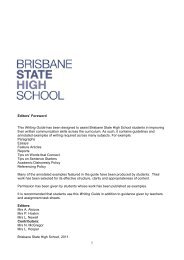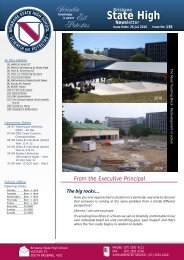Junior Curriculum Guide 2013-2014 - Brisbane State High School
Junior Curriculum Guide 2013-2014 - Brisbane State High School
Junior Curriculum Guide 2013-2014 - Brisbane State High School
- No tags were found...
You also want an ePaper? Increase the reach of your titles
YUMPU automatically turns print PDFs into web optimized ePapers that Google loves.
<strong>Junior</strong> <strong>Curriculum</strong> <strong>Guide</strong><strong>2013</strong> - <strong>2014</strong>
ContentsThe <strong>State</strong> <strong>High</strong> <strong>Curriculum</strong>Selecting Semester UnitsOpportunities for Extension and EnrichmentSummary of Learning Area Study RequirementsLearning Area: EnglishLearning Area: Health and Physical EducationLearning Area: Humanities and Social SciencesLearning Area: LanguagesLearning Area: MathematicsLearning Area: ScienceLearning Area: TechnologyLearning Area: The Arts2334 – 56 – 78 – 910 – 121314 – 1516 – 1718 – 2324 - 311
The <strong>State</strong> <strong>High</strong> <strong>Curriculum</strong><strong>Brisbane</strong> <strong>State</strong> <strong>High</strong> <strong>School</strong> has a diverse range of subjects that can be studied in Years 8 to 12. This is in parta function of our size, but also a product of our commitment to meeting the learning needs of a diverse studentpopulation with different strengths, areas of interest and future aspirations.The foundations of the school’s academic curriculum which guide the teaching and learning at BSHS include:• Teaching, Learning and <strong>Curriculum</strong> – <strong>State</strong>ment of Principles• A common pedagogical framework centred on “Dimensions of Learning”• The use of ICTs to support and enhance student understanding• The development of students’ multi-literacies• <strong>High</strong>er order thinking and problem solvingIn summary, we aim to create a curriculum structure that balances both student choice and our commitment toproducing well rounded individuals who participate well in broader society as young adults.Structure of the <strong>School</strong> Day• <strong>Brisbane</strong> <strong>State</strong> <strong>High</strong> <strong>School</strong> operates four 70 minute lessons each day.• Six subjects are studied in any one semester.• Each subject is timetabled for three 70 minute lessons each week.Learning AreasThere are eight Learning Areas around which our Year 8 & 9 <strong>Curriculum</strong> is structured.These Learning Areas are:English, Languages, Mathematics, Science, Health and Physical Education, Technology,Humanities and Social Sciences, The Arts.The subjects within each Learning Area in Years 8 & 9 are as follows:Learning AreaSubjects available in the Learning AreaEnglishEnglish, Aspire EnglishHealth and Physical EducationHealth and Physical EducationHumanities and Social SciencesHistory, Geography, Aspire HumanitiesLanguages (LOTE)French, German, Italian, Japanese, Modern GreekMathematics Mathematics, Fast Track Mathematics (commences Semester 2 of year 8)Science Science, Fast Track Science (commences Semester 2 of year 8)TechnologyBuilt Environment and Engineering, Industrial Technology andDesign, Aspire Engineering, Business Studies, InformationCommunication TechnologyThe ArtsDance, Drama, Media Arts, Music, Visual Art, Aspire Visual Art2
Selecting Semester Units1. Twelve units of study must be selected for the year (six per semester).2. The following subjects must be studied for two semesters in both year 8 & 9:o Englisho Mathematicso Science3. The following subjects must be studied for one semester in both year 8 & 9:o Historyo Health & Physical Educationo Languages (LOTE)o Technologyo The ArtsTo ensure a deep understanding of a subject within a Learning Area, students are expected to continuethese subjects from Year 8 into Year 9.4. Students may elect additional subjects from Humanities, Health and Physical Education, Languages,Technology, and The Arts to complete their twelve semester units.Refer to the details in each learning area and the Learning Plan document.5. Aspire subjects are studied for two semesters.6. Only one Aspire subject can be selected from: Aspire Humanities; Aspire Engineering; Aspire Art.Opportunities for Extension and EnrichmentAspire Subjects: English, Humanities, Engineering, Visual Art.<strong>Brisbane</strong> <strong>State</strong> <strong>High</strong> <strong>School</strong> is proud of the high academic calibre of its students. We offer an enrichmentcurriculum for students in which higher order, creative and lateral thinking, pace, complexity of challenge,appropriate degrees of independence and the development of the whole student are encouraged. These Aspiresubjects will be studied by students with an interest in developing their skills to a very high standard. To besuccessful in these subjects, students will need to be:• highly motivated• able to commit to independent work• interested in developing their creative and critical thinking skills.To ensure deep understanding of Aspire subjects, students are expected to continue an Aspire subject fromYear 8 into year 9.Fast Track Mathematics and Science<strong>Brisbane</strong> SHS also offers some students a fast track mathematics and/or science pathway. These uniquecourses are designed for students who are exceptionally gifted and talented at mathematics and/or science andculminate in students finishing their Year 12 maths and/or science six months earlier. This allows them to studya University maths and/or science subject as part of their normal timetable. A selection process will beconducted during the first semester of year 8 for students wishing to apply for a fast track pathway in mathsand/or science. These courses begin in Semester 2, Year 8.Support for Learning SuccessFor students experiencing some difficulty with their studies, the school provides support options through ourcurriculum structure. The school will determine the most appropriate method of support for individual studentsbased on student data and progress, and available school resources.3
Summary of Learning Area Study RequirementsLearning Area: EnglishStudents must study English in both semesters each year.There are two choices for students in this Learning Area:1. English2. Aspire EnglishLearning Area: Health and Physical EducationStudents must study HPE for one semester each year.Students may choose to study additional HPE units.Learning Area: Humanities and Social SciencesStudents must study History for one semester each year.Students may also study Geography for one semester in year 8 and/or year 9.There are three choices for students in this Learning Area:1. History (mandatory)2. Geography3. Aspire Humanities – must be studied for both semesters in each year.Learning Area: LanguagesStudents must study a Language for one semester each year.The language selected in year 8 must be continued in year 9.Students may study an additional language unit in year 9, semester two.There are five choices for students in this Learning Area:1. French2. German3. Italian4. Japanese5. Modern GreekYear 8Of these languages, French, German and Japanese are offered as either a Continuing course or Beginningcourse, based on primary school language learning.For Italian and Modern Greek, both Continuing and Beginning students are integrated into the same course.Students who learned at Primary school one of the languages offered at <strong>Brisbane</strong> <strong>State</strong> <strong>High</strong> <strong>School</strong> areexpected to continue learning that language in Year 8.Continuing students are those who:• Have successfully studied a language at primary school for two years or more.• For Japanese, have knowledge of the hiragana script.Beginning students are those who wish to either:• Start a new language in Year 8, or• Consolidate their language learning from primary school.Year 9Students who decide to do the minimum requirements for languages study will choose one semester unit forYear 9 in the same language as that studied in Year 8. This subject will be studied in Semester 1.Students who want to continue learning a language in Year 10 and/or Years 11 and 12 should choose to do twosemesters in that language in Year 9. This additional unit will be studied in Semester 2.4
Learning Area: MathematicsStudents must study Maths in both semesters each year.There are two choices for students in this Learning Area:1. Mathematics2. Fast Track Mathematics (By approved application only- commences in Semester 2 of year 8)Learning Area: ScienceStudents must study Science in both semesters each year.There are two choices for students in this Learning Area:1. Science2. Fast Track Science (By approved application only- commences in Semester 2 of year 8)Learning Area: TechnologyStudents must study a Technology subject for one semester each year.The subject selected in year 8 must be continued in year 9.Students may choose to study additional Technology units.There are five choices for students in this Learning Area:1. Built Environment and Engineering (two units offered per year)2. Industrial Technology and Design (two units offered per year)3. Business Studies (one unit only offered per year)4. Information Communication Technology (one unit only offered per year)5. Aspire Engineering (must be studied for both semesters in each year)Learning Area: The ArtsStudents must study an Arts subject for one semester each year.The subject selected in year 8 must be continued in year 9.Students may choose to study additional Arts units.There are six choices for students in this Learning Area:1. Dance (one unit only offered per year)2. Music (two units offered per year)3. Drama (two units offered per year)4. Media Arts (two units offered per year)5. Visual Art (two units offered per year)6. Aspire Visual Art (must be studied for both semesters in each year)5
Learning Area: EnglishStudents must study English in both semesters each year.There are two choices for students in this Learning Area:1. English2. Aspire EnglishEnglish is central to everyday life. It is important for us to be able to communicate our ideas, feelings, opinions,observations and information in order to understand, critique, appreciate and participate in the world that we livein. English offers purposeful learning activities in speaking, listening, reading, writing, viewing and representingin contexts that are relevant to the students.Year 8 & 9 will follow the Australian <strong>Curriculum</strong> for English, which develops the three interrelated strands ofLanguage, Literature and Literacy. Together the strands focus on developing students’ knowledge,understanding and skills in listening, reading, viewing, speaking, writing and creating. English will challengestudents to develop into dynamic communicators who can use language creatively, persuasively andanalytically. Students will be exposed to a range of literary, media and screen texts that will be relevant to theirown lives and also challenge them to expand their world-view.In English, students learn the following skills:• using the conventions of written English;• writing and responding in a variety of styles;• listening carefully and speaking clearly and coherently;• reading fluently and with perception;• using a dictionary and thesaurus regularly and naturally,• appreciating a variety of literature including popular culture;• reading / viewing newspapers and other non-literary textsYear 81. EnglishIn English, students’ knowledge, understanding and skills in listening, reading, viewing, speaking, writing andcreating are developed. Learning in English builds on concepts, skills and processes developed in earlier years,and teachers will revisit and strengthen these as needed.Year 8 English will focus on:• Representations of teenagers in the media, and in literary texts;• Poetry and other texts that represent Aboriginal and Torres Strait Islander histories and cultures;• Life Writing;• A Shakespearean play;• E-literature2. Aspire EnglishIn Aspire English, students are introduced to both contemporary and classic literature. Aspire English covers awide range from current authors to Shakespeare, from popular fiction to classic poems, and from the writtenword to stage performances and film adaptation. Aspire English involves significant student directed inquiry.The reading of challenging texts is required, and there is a strong emphasis on class discussion, participation,and the sharing of ideas based on the readings. A wide and varied reading program underpins Aspire English.Year 8 Aspire English will focus on:• Representations of teenagers in the media, and in canonical literary texts;• Poetry and other texts that represent Aboriginal and Torres Strait Islander histories and cultures;• Life Writing;• A Shakespearean play;• E-literature texts from contemporary and classic literature6
Year 91. EnglishIn English, students’ knowledge, understanding and skills in listening, reading, viewing, speaking, writing andcreating are developed. Learning in English builds on concepts, skills and processes developed in earlier years,and teachers will revisit and strengthen these as needed.Year 9 English will focus on:• Representations of Australia’s peoples, histories and cultures in the media, and in literary texts;• Personal narratives and fiction about Aboriginal and Torres Strait Islander histories and cultures;• Speculative fiction• Australia’s engagement with Asia as represented in literary and non-literary texts• A Shakespearean play2. Aspire EnglishIn Aspire English, students continue exploring both contemporary and classic literature. Aspire English covers awide range from current authors to Shakespeare, from popular fiction to classic poems, and from the writtenword to stage performances and film adaptation. Aspire English involves significant student directed inquiry.The reading of challenging texts is required, and there is a strong emphasis on class discussion, participation,and the sharing of ideas based on the readings. A wide and varied reading program underpins Aspire English.Year 9 Aspire English will focus on:• Representations of Australia’s peoples, histories and cultures in the media, and in literary texts;• Personal narratives and fiction about Aboriginal and Torres Strait Islander histories and cultures;• Speculative fiction;• Australia’s engagement with Asia as represented in literary and non-literary texts• Characters and intertextuality in Australian novels• A Shakespearean play7
Learning Area: Health and Physical EducationStudents must study HPE for one semester each year.Students may choose to study additional HPE units.Year 8Health and Physical Education provides a foundation for students to enhance their own and others’ health andwellbeing in varied contexts and to adopt lifelong healthy, active living. Students will learn about key issuesaffecting the health and wellbeing of young people and their communities and learn how to apply problemsolving techniques to these issues. They will acquire movement skills, concepts and strategies that enable themto confidently and competently participate in a range of physical activities.Year 8 Health and Physical Education is comprised of the following topics:1. Social view of health2. Nutrition3. Health related fitness4. Adolescent development5. Sun and water safety6. Principles of Training7. Training ProgramsTopics 4 -7: studied in the second HPE unit onlyIn HPE students will engage with the following practical domains:1. Invasion Games such as: Speedball, Soccer, Handball and Sof cross2. Indigenous games3. Athletics4. Invasion Games such as: Basketball, Netball, Water Polo, Hockey (Field or Indoor)5. LifesavingActivities 4 & 5: studied in the second HPE unit onlyThe following skills are incorporated into a study of HPE:• work independently• work interdependently• research, analyse and evaluate data, information and evidence• draw conclusions and make decisions to construct arguments• synthesising information from a variety of sources and perspectives• propose, justify, implement and monitor plans or actions to achieve goals• create and perform movement sequences by manipulating and combining movement skills and• applying movement concepts• reflect on learning, apply new understandings and justify future applications8
Year 9Health and Physical Education provides a foundation for students to promote their own and others’ health,wellbeing, safety and participation in physical activity across their lifespan in varied and rapidly changingcontexts. It also provides students the opportunity to engage in healthy, active living. Students will learn aboutkey issues affecting the health and wellbeing of young people and their communities and learn how to applyproblem solving techniques to these issues. They will create and perform a variety of movement sequences byapplying concepts and strategies that enable them to confidently and competently participate in a range ofphysical activities.Year 9 Health and Physical Education is comprised of the following topics:1. Mental Health2. Sport Psychology3. Personal Safety4. Biomechanics (Levers)5. Influences on participation in sport e.g. media and popular culture6. Biomechanics (Base of Support, Centre of Gravity)Topics 5 & 6: studied in the second HPE unit onlyIn HPE students will engage with the following practical domains:1. Fielding Games such as: Softball, Tee Ball and Vigoro2. Dance (Bush or Square)3. Athletics4. Fielding Games such as: Cricket, Indoor Cricket and Baseball5. Games of the WorldActivities 4 & 5: studied in the second HPE unit onlyThe following skills are incorporated into a study of HPE:• work independently• work interdependently• research, analyse and evaluate data, information and evidence• draw conclusions and make decisions to construct arguments• synthesising information from a variety of sources and perspectives• propose, justify, implement and monitor plans or actions to achieve goals• create and perform movement sequences by manipulating and combining movement skills andapplying movement concepts• reflect on learning, apply new understandings and justify future applications9
Learning Area: Humanities and Social SciencesStudents must study History for one semester each year.Students may also study Geography for one semester in year 8 and/or year 9.There are three choices for students in this Learning Area:1. History (mandatory)2. Geography3. Aspire Humanities – must be studied for both semesters in each year.Year 81. HistoryHistory is the study of people, events and place over time. The following units of work have been developedusing the Australian <strong>Curriculum</strong>: History. Year 8 focuses on the Ancient to the Modern World, study of historyfrom the end of the ancient period to the beginning of the modern period, c.650AD (CE)-1750. This was whenmajor civilisations around the world came into contact with each other. Social, economic, religious and politicalbeliefs were often challenged and significantly changed. It was the period when the modern world began to takeshape.Year 8 History is comprised of the following topics:1. Medieval Europe2. Japan under the Shoguns3. The Spanish Conquest of the AmericasThese units provide opportunities to develop historical understanding through key concepts, including evidence,continuity and change, cause and effect, perspectives, empathy, significance and contestability.The following skills will also be developed:• Sequence historical events, developments and periods• Use of historical terms and concepts• Identify a range of questions about the past to inform a historical inquiry• Identify and locate relevant sources, using ICT and other methods• Identify the origin and purpose of primary and secondary sources• Locate, compare, select and use information from a range of sources as evidence• Draw conclusions about the usefulness of sources• Identify and describe points of view, attitudes and values in primary and secondary sources• Develop texts, particularly descriptions and explanations that use evidence from a range of sources• Use a range of communication forms (oral, graphic, written) and digital technologies10
2. GeographyGeography is a structured way of exploring, analysing and explaining the characteristics of the places that makeup our world. The following units of work have been developed using the Australian <strong>Curriculum</strong>: Geography.Year 8 focuses on Australia’s physical and human environments and will look closely at relationships betweenthese factors.1. Finding your way (basic geographic skills and mapping)2. Landforms and Landscapes3. Population, settlements and migrationThese units provide opportunities to develop geographic understanding through key concepts, including places,space, environments, interconnection, sustainability, scale and change.The following skills will also be developed:• Develop spatial literacy skills• Plan and conduct a simple geographical inquiry• Collect and interpreting data in the field• Identify, collect and use relevant sources of primary and secondary data to answer questions• Use a range of analytical methods to identify and analyse trends and patterns eg satellite images• Use spatial and information technologies to represent and analyse information• Deliver conclusions using a range of communication forms: oral, graphic, written, digitalStudents in Year 8 Geography will be expected to participate in a field trip.3. Aspire Humanities – History and GeographyBased on the History and Geography courses listed above, this is a full year enrichment course for studentswith an interest in the Humanities and Social Sciences. The course is framed around six ‘Big Ideas’ of globalsignificance: war and peace, power, social and political systems, science and technology, civilisation andreligion.There is an emphasis on higher order thinking and the embedding of philosophical approaches when dealingwith challenging subject matter. The teaching approach is based around different cooperative learning anddecision making strategies.The topics will include:1. Medieval Europe, with a focus on religion, power, war and peace2. Japan under the Shoguns, with a focus on war and peace, social and political systems3. Spanish Conquests of the Americas, with a focus on science and technology, civilisation4. Where in the world? (using Geography skills to negotiate a journey around the world)5. Landforms and Landscapes, with a focus on how landscapes are perceived and used6. Population, settlements and migration, with a focus on inequalityIn Aspire Humanities, the following skills are learnt:• deciphering different types of maps• analysing and interpreting data from graphs, tables, photos, maps and drawings• creating digital maps with multiple layers in ArcView software package• writing paragraphs, essays and reports• collecting and interpreting data in the field• using geographic inquiry to understand current issues• library, internet and database research techniques• comprehending, analysing and evaluating primary and secondary sources• synthesising information from a variety of sources• forming arguments and hypotheses• using criteria to make decisions• evaluating issues, events and people from a variety of perspectivesStudents in Year 8 Aspire Humanities will be expected to participate in a field trip.11
Year 91. HistoryHistory is the study of people, events and place over time. A strong emphasis is made in this course in linkingevents from the past with issues and developments of the present.The course has been designed according to the Australian <strong>Curriculum</strong>: History for Year 9Year 9 History is comprised of the following topics:1. The Industrial Revolution2. Asia and the World – India between 1750-19183. World War 1In History, the following skills are learnt:• library, internet and database research techniques• use of historical terms and concepts• comprehending, analysing and evaluating primary and secondary sources• synthesising information from a variety of sources and perspectives2. GeographyYear 9 Geography is comprised of the following topics:1. Physical and Human characteristics of Australia2. Natural Hazards – incorporating a study using Geographic Information Systems (GIS)3. Community study of South <strong>Brisbane</strong>In Geography, the following skills are learnt:• analysing and interpreting data from graphs, tables, photos, maps and drawings• developing spatial literacy skills• creating digital maps with multiple layers in ArcView software package• writing paragraphs and reports• collecting and interpreting data in the field• using the geographic inquiry to develop an understanding of current issues.3. Aspire Humanities – History and GeographyBased on the History and Geography courses listed above, this is a full year enrichment course for studentswith an interest in the Humanities and Social Sciences. There is a deeper understanding of course material thanwould normally be the case, including an emphasis on higher order thinking and the embedding of philosophicalapproaches when dealing with challenging subject matter. The teaching approach is based around differentcooperative learning and decision making strategies, including a heavy emphasis on using ICTs as a decisionmaking and presentation tool.In addition to the skills listed above, in Aspire Humanities the following skills are learnt:• using criteria to make decisions• evaluating issues, events and people from a variety of perspectives• designing solutions, alternatives and proposals12
Learning Area: LanguagesStudents must study a Language for one semester each year.The language selected in year 8 must be continued in year 9.Students may study an additional language unit in year 9, semester two.There are five choices for students in this Learning Area:1. French2. German3. Italian4. Japanese5. Modern GreekYear 8Of these languages, French, German and Japanese are offered as either a Continuing course or Beginningcourse, based on primary school language learning.For Italian and Modern Greek, both Continuing and Beginning students are integrated into the same course.Students who learned at Primary school one of the languages offered at <strong>Brisbane</strong> <strong>State</strong> <strong>High</strong> <strong>School</strong> areexpected to continue learning that language in Year 8.Continuing students are those who:• Have successfully studied a language at primary school for two years or more.• For Japanese, have knowledge of the hiragana script.Beginning students are those who wish to either:• Start a new language in Year 8, or• Consolidate their language learning from primary school.Year 9Students who decide to do the minimum requirements for languages study will choose one semester unit forYear 9 in the same language as that studied in Year 8. This subject will be studied in Semester 1.Students who want to continue learning a language in Year 10 and/or Years 11 and 12 should choose to do twosemesters in that language in Year 9. This additional unit will be studies in Semester 2.Year 8 & 9For all Languages, the topics studied are drawn from the following:1. Personal identity2. <strong>School</strong> routines3. Family and friends4. Expressing likes and dislikes; abilities and opinions5. Place and time6. Daily routines7. Holidays and festivals8. Houses and homes9. Leisure activities and daily routines10. Going places, talking about weather, counting costsThe common elements of all Language courses offered at <strong>State</strong> <strong>High</strong> are:• A focus on the four skills of :Listening; Speaking; Reading; Writing• Integrating cultural understanding with language learning• An experience of the cuisine of the country• Incorporate the latest ICTs to enhance language learning experiences• Opportunities to interact with exchange students from the country13
Learning Area: MathematicsStudents must study Maths in both semesters each year.There are two choices for students in this Learning Area:1. Mathematics2. Fast Track Mathematics (By approved application only- commences in Semester 2)Year 81. MathematicsThe study of Mathematics aims to ensure that students:• are confident, creative users and communicators of mathematics, able to investigate, represent andinterpret situations in their personal and work lives and as active citizens• develop an increasingly sophisticated understanding of mathematical concepts and fluency with processes,and are able to pose and solve problems and reason• recognise connections between the areas of mathematics and other disciplines and appreciatemathematics as an accessible and enjoyable discipline to studyThe Australian <strong>Curriculum</strong>: Mathematics involves the study of the following three strands:• Number and Algebra• Statistics and Probability• Measurement and GeometryIn Mathematics, the students learn the following skills and processes:• Understanding and fluency with mathematical scenarios• Problem solving and investigation of mathematical scenarios• Reasoning and communicating ideas in a variety of ways2. Fast Track MathematicsThe Mathematics Fast Track program is designed to deliver Years 8, 9 and 10 Australian <strong>Curriculum</strong> outcomesover four semesters and will allow students to begin studying senior Maths B course during Semester 2, Year10. The following diagram outlines the course plan.Year 8 Semester 1Normal CourseFast Track CourseYear 8 Semester 2 Year 8 Semester 2and Year 9 Semester 1Year 9 Semester 1 Year 9 Semester 2Year 9 Semester 2 Year 10 Semester 1Year 10 Semester 1Year 10 Semester 2Year 10 Semester 2Year 11 Mathematics BYear 11 & Year 12Complete Mathematics BOne Semester University14
Year 91. MathematicsThe study of Mathematics aims to ensure that students:• are confident, creative users and communicators of mathematics, able to investigate, represent andinterpretsituations in their personal and work lives and as active citizens• develop an increasingly sophisticated understanding of mathematical concepts and fluency with processes,and are able to pose and solve problems and reason• recognise connections between the areas of mathematics and other disciplines and appreciatemathematics as an accessible and enjoyable discipline to studyThe Australian <strong>Curriculum</strong>: Mathematics involves the study of the following three strands:• Number and Algebra• Statistics and Probability• Measurement and GeometryIn Mathematics, the students learn the following skills and processes:• Understanding and fluency with mathematical scenarios• Problem solving and investigation of mathematical scenarios• Reasoning and communicating ideas in a variety of ways• Using technology to aid mathematical skill2. Fast Track MathematicsThe Mathematics Fast Track program is designed to deliver Years 8, 9 and 10 Australian <strong>Curriculum</strong> outcomesover four semesters and will allow students to begin studying senior Maths B course during Semester 2, Year10. The following diagram outlines the course plan.Year 8 Semester 1Normal CourseFast Track CourseYear 8 Semester 2 Year 8 Semester 2and Year 9 Semester 1Year 9 Semester 1 Year 9 Semester 2Year 9 Semester 2 Year 10 Semester 1Year 10 Semester 1Year 10 Semester 2Year 10 Semester 2Year 11 Mathematics B•Year 11 & Year 12Complete Mathematics BOne Semester University15
Learning Area: ScienceStudents must study Science in both semesters each year.There are two choices for students in this Learning Area:1. Science2. Fast Track Science (By approved application only- commences in Semester 2 of year 8)The study of science provides opportunities for students to develop an understanding of important scienceconcepts and processes, the practise used to develop scientific knowledge, of science’s contribution to ourculture and processes and its application in their lives.Our science course seeks to support students to develop the scientific knowledge, understandings and skills tomake informed decisions about local, national and global issues and to participate in science related careers.The Australian <strong>Curriculum</strong>: Science promotes six overarching ideas: patterns, order and organisation; form andfunction; stability and change; systems; scale and measurement; and matter and energy and all are addressedin our junior science program.Year 81. ScienceYear 8 Science is comprised of the following term units:1. Matter – focusing on the Chemical Science sub-strand2. Energy Converters- focusing on the Physical Science sub-strand3. Multiplying to Divide – focusing on the Biological Science sub-strand4. Let’s Rock- focusing on the Earth and Space sub-strand2. Fast Track ScienceThe Science Fast Track program is designed to deliver Years 8, 9 and 10 Australian <strong>Curriculum</strong> outcomes overfour semesters and will allow students to begin studying a senior science course during Semester 2, Year 10.The following diagram outlines the course plan.Year 8 Semester 1Normal CourseFast Track CourseYear 8 Semester 2A focus on Earth ScienceYear 9 Semester 1A focus on Biological ScienceYear 9 Semester 2A focus on Chemical ScienceYear 10 Semester 1A focus on Physical ScienceYear 10 Semester 2Year 11 Physics or ChemistryYear 11 & Year 12Complete Physics or ChemistryOne Semester University16
Year 91. ScienceYear 9 Science is comprised of the following term units:1. Balancing My Life – focusing on the Biological Science sub-strand2. Reacting Matter – focusing on the Chemical Science sub-strand3. A Changing Environment – focusing on the Earth and Space and Biological Science sub-strands4. Waves – focusing on the Physical Science sub-strand2. Fast Track ScienceThe Science Fast Track program is designed to deliver Years 8, 9 and 10 Australian <strong>Curriculum</strong> outcomes overfour semesters and will allow students to begin studying a senior science course during Semester 2, Year 10.The following diagram outlines the course plan.Year 8 Semester 1Normal CourseFast Track CourseYear 8 Semester 2A focus on Earth ScienceYear 9 Semester 1A focus on Biological ScienceYear 9 Semester 2A focus on Chemical ScienceYear 10 Semester 1A focus on Physical ScienceYear 10 Semester 2Year 11 Physics or ChemistryYear 11 & Year 12Complete Physics or ChemistryOne Semester University17
Learning Area: TechnologyStudents must study a Technology subject for one semester each year.The subject selected in year 8 must be continued in year 9.Students may choose to study additional Technology units.There are five choices for students in this Learning Area:1. Built Environment and Engineering (two units offered per year)2. Industrial Technology & Design (two units offered per year)3. Business Studies (one unit only offered per year)4. Information Communication Technology (one unit only offered per year)5. Aspire Engineering (must be studied for both semesters in each year)Year 81. Built Environment and EngineeringIn this subject, students will gain the fundamental knowledge in methods of drawing and designing forArchitecture and Engineering. There is a strong emphasis on real life applications, using industry standardsoftware.Topics:1. Introduction to CAD (Computer-Aided Design)2. Landscape architecture3. Graphical communication drawing4. Graphic design concepts5. 2D and 3D elements and principles of design6. Computer game / fashion magazine context based folio7. Advertising and marketing(Topics 4-7 are studied in the second BEE unit only).In Built Environment and Engineering the following skills are learnt:• designing and creating context based design folios• planning – investigating and research techniques, interpreting, sketching ideas and communicating• refining– critical thinking to problem solve, optimising and evaluating a design• producing 2D and 3D computer aided drawings whilst applying formal standards and conventions• learning to use industry standard software (Catia, Revit Architecture, AutoCAD, Corel Draw and the Adobesuite of design programs)18
2. Industrial Technology and DesignIndustrial Technology and Design focuses on the development of manual, electronic and technological skills inthe designing and manufacturing of products in timber, metal, plastics, composites and textiles. Studentsexpand their capabilities as confident, critical and creative designers and users of technology.Year 8 Industrial Technology and Design is comprised of the following topics:1. The Design Process2. Properties of Materials3. Applied Mathematics and Science4. Computer aided design and computer aided manufacturing (CAD-CAM) utilising a CNC lathe, laser cutterand 3D printers.In Industrial Technology and Design, the following skills are learnt:• Sketching and /or formally drawing design solutions• Safe use of machine, hand and power tools in accordance with OH&S• Metal manipulation, timber joining, shaping and finishing• Plastic thermoforming and solvent bonding• Design and documentation of the design process using ICT• Use of high end technology for rapid prototyping – 3D printer, laser cutter and router3. Business StudiesStudents learn about the principles of business operations, including finance, banking and legal issues affectingbusinesses and households. IT applications are integrated into the programme of study.Year 8 Business Studies is comprised of the following topics:1. Goal setting2. Personal financial records and personal credit3. Financial planning – budgeting and spreadsheetingIn Business Studies, students learn the following skills:• analysing and evaluating business and personal financial decisions• interpreting and evaluating legal and ethical issues• working in a team• writing reports• creating complex worksheets in Excel, including formulae19
4. Information Communication TechnologyStudents learn how to effectively use Information Communication Technology (ICT) applications in a variety ofcontexts. This subject is useful for students with a range of IT capabilities. Students will produce a digitalportfolio of work completed.Year 8 Information Communication Technology is comprised of the following topics:1. Graphic design software2. Digital copyright3. Desktop publishing using Microsoft Word4. PhotoShopIn Information Technology, students learn the following skills• Problem solving through computer applications• Creative thinking in planning, producing and evaluating original computer generated documents and images.• Technical manipulation of images, text and data in popular software applications• Report writing5. Aspire EngineeringAspire Engineering builds on lateral, creative and higher order thinking by delving into all facets of Engineeringin real world contexts. A variety of delivery mediums will be utilised in order to create an environment wherecreative thinking and problem solving is encouraged. The use of guided practical and theoretical activities,design tasks and group work is integral to the program. <strong>High</strong>er order thinking will be evident in the designprocess, ways of thinking, and problem solving required for all classroom activities and assessment.The students’ main focus for Year 8, in mechanical engineering, will utilise both industry standard software aswell as theoretical concepts. The students will also be required to design, make and test a medieval trebuchetthrough the use of engineering concepts.Study topics will include:1. Manufacturing Engineering2. Mechanical Engineering3. Civil Engineering conceptsIn Aspire Engineering the following skills are learnt:• Learning to use industry standard 3D modelling software, in CATIA;• Utilising CATIA to design and create trebuchet and engineering components• Utilising software to manufacture trebuchet and engineering components with a laser cutter• Analysing and testing different types of materials• Engage and apply engineering mechanics and materials theory to practical components20
Year 91. Built Environment and Engineering1. ‘Built Environment,’ refers to the indoor and outdoor space that has been structurally changed by humanaction.2. ‘Engineering’ or production graphics refers to the study of engineering principles in relation to anengineered product or designed artefact.Students selecting one semester of study will focus on the ‘Built Environment’ to design a sustainable house.Students will apply industry practice and industry standard CAD software as an architect would in real life.Students selecting two semesters of study will also focus on ‘Engineering’ graphics. Students will use industrystandard 3D modelling software to create drawings, photo realistic renderings, animations and apply FiniteElement analysis (structural strength analysis) testing to their engineered product.In Built Environment and Engineering the following skills are learnt:• Designing buildings in CAD and creating context based design folios• Planning - investigating and research techniques, interpreting, sketching ideas and communicating• Refinement - critical thinking to problem solve, optimising and evaluating a design2. Industrial Technology and DesignIndustrial Technology and Design focuses on the development of manual, electronic and technological skills inthe designing and manufacturing of products in timber, metal, plastics, composites and textiles.Students expand their capabilities as confident, critical and creative designers and users of technology.Year 9 Industrial Technology and Design is comprised of the following topics:1. The Design Process2. Properties of Materials3. Applied Mathematics4. Computer aided design and computer aided manufacturing (CAD-CAM) utilising a CNC lathe,programmable router and / or laser cutter, and 3D printer.In Industrial Technology and Design, the following skills are learnt:• Sketching and /or formally drawing design solutions• Safe use of machine, hand and power tools in accordance with OH&S• Metal manipulation, timber joining, shaping and finishing• Plastic thermoforming and solvent bonding• Design and documentation of the design process using ICT• Use of high end technology for rapid prototyping – 3D printer, laser cutter and router21
3. Business StudiesThis unit provides students with the opportunity of exploring how the decision making process within Australiansociety works. Students will investigate and analyse personal investment opportunities available and the uniquepurchasing practices of young people.Year 9 Business Studies comprises of the following topics:1. Australian legal and political system2. Consumer awareness and protection3. Investing4. Purchasing practices and power of young people5. E business for the consumer6. Advanced spreadsheetingIn Business Studies, students learn the following skills• Researching and analysing data, information and evidence from primary and secondary data• Reflecting on learning, by evaluating and justifying position taken• Writing paragraphs and reports with a view to an intended audience• Interpreting, analysing, synthesising and evaluating information from a range of business contexts4. Information Communication TechnologyThis unit allows students to design, develop and evaluate advanced websites for individual clients through theuse of case studies. The students develop independent study and evaluative techniques through the self-pacedunit with teacher-guided assistance in technical elements of industry standard software. Students evaluate andreflect on their websites considering industry requirements.Year 9 Information Communication Technology comprises of the following topics:1. Web design using Dreamweaver2. Incorporation of animated images into websites.In Information Communication Technology, students learn the following skills• Creative thinking in planning, producing and evaluating original web site• Research and evaluation of websites• Creating original web sites• Critical thinking and problem solving techniques to manipulate the software package22
5. Aspire EngineeringAspire Engineering builds on lateral, creative and higher order by delving into all facets of Engineering in realworld contexts. Students will participate in the Re-Engineering Australia Formula 1 in schools competition tocompete with students from other schools. This tournament could eventually enable a group of students toparticipate internationally.A variety of delivery mediums will be utilised in order to create an environment where creative thinking andproblem solving is encouraged. The use of guided practical and theoretical activities, design tasks and groupwork is integral to the program. <strong>High</strong>er order thinking will be evident in the design process, ways of thinking(working), robotic programming and mathematical problem solving required for all classroom activities.Study topics will include:1. Manufacturing Engineering2. Infomechatronics Engineering3. Mechanical Engineering4. Civil Engineering.In Aspire Engineering the following skills are learnt:• Analysing CATIA Engineering design software;• Utilising CATIA to conduct testing of structures, displacements, aerodynamics and human modelling;• Create a CNC program for Denford router as part of the CAD/CAM process• Deciphering basic and intermediate electronics and programming• Design and manufacture an item that requires electronics and utilises the CAD/CAM process• Creating NXT engineering robotics projects• Conduct structural analysis of their Formula 1design utilising CATIA• Analysing and testing of materials23
Learning Area: The ArtsStudents must study an Arts subject for one semester each year.The subject selected in year 8 must be continued in year 9.Students may choose to study additional Arts units.There are six choices for students in this Learning Area:1. Dance (one unit only offered per year)2. Music (two units offered per year)3. Drama (two units offered per year)4. Media Arts (two units offered per year)5. Visual Art (two units offered per year)6. Aspire Visual Art (must be studied for both semesters in each year)Year 81. DanceIn Dance practice, students explore a range of dance forms and styles through practical and theoreticalactivities. Students will be introduced to choreography, performance and appreciation. They will create dances,perform dances which are either teacher or student devised and will reflect upon dances and dance elements inwritten and oral form.No former experience in Dance is required to study this subject.Year 8 Dance is comprised of the following topics:1. Popular dance and youth culture dance styles2. Dance in music video3. Social dance and its place in past and present societyIn Dance, students develop the following skills and processes:• the Elements of Dance• safe dance practices• choreographic processes• performance techniques• appreciation model for reviewing Dance2. MusicIn Music practice, students will participate in activities designed to introduce the skills of aural and visualanalysis, singing and playing and reading and writing of music. Students will participate in solo and small groupvocal performance, composition activities, study music vocabulary and notation and generally explore a varietyof musical genre.Students of instrumental music will extend their skills of performance and other students will have access toclassroom instruments including keyboards, guitars and voice.24
Year 8 Music is comprised of the following topics:1. The Elements of Music – rhythm, melody, harmony metre, etc.2. Performing repertoire – in a variety of styles and genres3. Musical notation – rhythmic and melodic4. Student devised composition – using Sibelius software5. Analysis of music in a variety of styles and genres6. Aural notation and score reading7. Individual project or productions under the guidance of a teacher8. Performance skills eg. etiquette, technology, presentation, nerves, marketing9. Compositional skills – role of the composer/creator of music10. Preparation for real event and/or production(Topics 8-10 are studied in the second music unit only).In Music, students develop the following skills and processes:• performing relevant repertoire in class (solo and small group)• identifying and reproducing rhythms• notating music• composing music on the pentatonic, major and minor scales with corresponding chord progression• using studied music vocabulary and notation and reading scores• analysing studied pieces• notating and performing melodies and rhythms3. DramaIn Drama practice, students explore a range of dramatic forms and styles through practical activities. Studentswill be introduced to forming (making of drama), and responding (in written and oral forms). Students willparticipate in improvisations and practical activities serving to introduce the foundations of the actor’s anddramatist’s craft.Year 8 Drama is comprised of the following topics:1. The Elements of Drama (how Drama works)2. Improvisation and characterisation3. Skills of performance – voice and movement4. Scripted drama5. The nature and elements of comedy6. Performing and creating a variety of comic pieces (including stand-up comedy)7. Analysis of comic performances(Topics 5-7 are studied in the second drama unit only).In Drama, students develop the following skills and processes:• the Elements of Drama• improvisational techniques• creating believable characterisation• use of voice, movement, space, focus etc.• exploring a range of theatrical forms, styles and contexts• reading, analysing and performing scripts• reflecting upon performance and process in written and oral forms• working in groups25
4. Media ArtsMedia Arts is an art form evolving in the twenty-first century enabling students to use existing and emergingtechnologies. Students will explore innovative methods of creative expression utilising video, animation,computer-based art and other sound and communication new media technologies.In Year 8 units focus on:1. Characters in still and moving images2. Identity in filmIn Media Arts students explore five interrelated key concepts in making and responding tasks:• Languages – codes and conventions in media arts• Representation – constructing characters, place, ideas and images• Audience – audiences for whom media arts products are made• Technologies – producing, accessing and distributing media• Institutions – organisations that enable and constrain media productionIn Media Arts, students develop the following skills:• Animation and film creation using a range of technologies and techniques• Research and evaluation of purpose and context in a range of media arts works• Analysing and applying codes and conventions of media arts works• Planning and implementing processes to work individually and in groups5. Visual ArtIn studio practice, students explore a range of traditional art mediums and develop a diverse folio of work. Theyalso learn to write about art and develop skills of critical analysis and interpretation. Visual Art classes takeadvantage of their proximity to the Southbank cultural precinct by taking part in regular visits to exhibits.Year 8 Visual Art is comprised of the following topics:1. Culture2. Identify3. Natural and built environments - studied in the second Visual Art unit only.In Visual Art, students develop the following skills and processes:• studio practice in drawing, painting, ceramics, printmaking and electronic imaging• digital photography and PhotoShop• designing multimodal presentations• analysing and evaluating artworks26
6. Aspire Visual ArtThe Visual Art Aspire subject aims to extend students by providing them with opportunities to use and applycreative thinking and problem solving techniques. The program will incorporate an inquiry learning modelthrough the four phases of research, development, resolution and reflection.Studio work will encompass the traditional fine art practice of painting, printmaking, drawing and ceramics, aswell as contemporary information and communication technologies. Whilst the work will be teacher directed,there will be opportunities for individual negotiation and independent research particularly around thematicaspects of learning activities. Projects will have an element of collaboration in at least one of the four learningphases.The students will be involved in developing some online resources that will be accessible by other students (egin a ‘junior critic’ role). This is a unique opportunity offered exclusively to our school for students in this program.This has been negotiated with the Queensland Art Gallery. The students will have an important role incollaborating with QAG staff to help deliver their education resources to their target audience of young people.Our students will have access to lecture theatres and other ‘behind the scenes’ resources as part of thispartnership.Students taking part in the Aspire program will enjoy a special relationship and privileges with QAG and GOMAas part of regular class visits and a variety of learning experiences that promote an appreciation of art and therole of the artist in society.27
Year 91. DanceIn Dance practice, students further explore a range of dance forms and styles through practical and theoreticalactivities. Students will further study choreography, performance and appreciation. They will create dances,perform dances which are either teacher or student devised and will reflect upon dances and dance elements inwritten and oral form.Year 9 Dance is comprised of the following topics:1. The functions of dance: ritual, social and artistic2. Contemporary dance performance3. Ritual dance and choreography of a ritual dance4. Social dance and appreciation of social dance5. Students will devise and perform dance works for a real audienceIn Dance, students develop the following skills and processes:• the Elements of Dance• safe dance practices• choreographic processes• performance techniques• appreciation model for reviewing Dance2. MusicIn Music practice, students will participate in activities designed to introduce the skills of aural and visualanalysis, singing and playing and reading and writing of music. Students will participate in solo and small groupvocal performance, composition activities, study music vocabulary and notation and generally explore a varietyof musical genre.Students of instrumental music will further extend their skills of performance and other students will haveaccess to classroom instruments including keyboards, guitars and voice.Year 9 Music is comprised of the following topics:1. The Elements of Music2. Performing repertoire, including vocal activities3. Music for the theatre, e.g. musicals and rock operas4. Student-devised composition5. Analysis of studied pieces6. Aural notation and score reading7. Creating music and performing for a real event and audience8. Elements of Jazz9. Performing in various Jazz styles and genres10. Composition of a Blues melody with ensemble11. Analysis of jazz excerpts(Topics 8-11 are studied in the second music unit only).28
In Music, students develop the following skills and processes:• the performance of relevant repertoire in class (solo and small group)• identifying and reproducing rhythms• notating music• composing music on the pentatonic, major and minor scales with corresponding chord progression• using studied music vocabulary and notation and reading scores• analysing studied pieces• aurally notate and perform melodies and rhythms3. DramaIn Drama practice, students further explore a range of dramatic forms and styles through practical activities.Students will further study forming (making of drama), presenting and responding (in written and oral forms).Students will participate in improvisations and practical activities serving to introduce the foundations of theactor’s and dramatist’s craft.Year 9 Drama is comprised of the following topics:1. The Elements of Drama2. Physical Theatre activities – non text based activities3. Skills of performance – particularly in movement4. Writing scripts and playbuilding5. Creation of a dramatic event for a real audience6. Ensemble skills – performance, rehearsal, preparation7. Design and backstage tasks8. Scripting, improvisation, editing techniques(Topics 5-8 are studied in the second drama unit only).In Drama, students develop the following skills and processes:• the Elements of Drama• improvisational techniques• creating believable characterisation• use of voice, movement, space, focus etc• exploring a range of theatrical forms, styles and contexts• reading, analysing and performing scripts• reflecting upon performance and process in written and oral forms• working in groups29
4. Media ArtsMedia Arts in an art form evolving in the twenty-first century enabling students to use existing and emergingtechnologies. Students will explore innovative methods of creative expression utilising video, animation,computer-based art and other sound and communication new media technologies.Year 9 Media is comprised of the following topics:1. Advertising campaigns using animation2. Title sequences and genre in filmIn Media Arts students explore five interrelated key concepts in making and responding tasks:• Languages – codes and conventions in media arts• Representation – constructing characters, places ideas and images• Audience – audiences for whom media arts products are made• Technologies – producing, assessing and distributing media• Institutions – organisations that enable and constrain media productionIn Media Arts, students develop the following skills:• Animation and film creation using a range of technologies and techniques• Research and evaluation of purpose and context in a range of media arts works• Analysing and applying codes and conventions of media arts works• Planning and implementing processes to work individually and in groups5. Visual ArtIn studio practice, students explore a range of traditional art mediums and develop a diverse folio of work. Theyalso learn to write about art and develop skills of critical analysis and interpretation. Visual Art classes takeadvantage of their proximity to the Southbank cultural precinct by taking part in regular visits to exhibits.Year 9 Visual Art is comprised of the following topics:1. Art and the Environment2. Art and Narrative - studied in the second Art unit onlyIn Visual Art, students develop the following skills and processes:• studio practice in drawing, painting, ceramics, printmaking and electronic imaging• digital photography and PhotoShop• designing multimodal presentations• analysing and evaluating artworks and writing analytical essays with a research component30
6. Aspire Visual ArtThe Visual Art Aspire subject aims to extend students by providing them with opportunities to use and applycreative thinking and problem solving techniques. The program will incorporate an inquiry learning modelthrough the four phases of research, development, resolution and reflection.Studio work will encompass the traditional fine art practice of painting, printmaking, drawing and ceramics, aswell as contemporary information and communication technologies. Whilst the work will be teacher-directed,there will be opportunities for individual negotiation and independent research particularly around thematicaspects of learning activities. Projects will have an element of collaboration in at least one of the four learningphases.The students will be involved in developing some online resources that will be accessible by other students (egin a ‘junior critic’ role). This is a unique opportunity offered exclusively to our school for students in this program.This has been negotiated with the Queensland Art Gallery. The students will have an important role incollaborating with QAG staff to help deliver their education resources to their target audience of young people.Our students will have access to lecture theatres and other ‘behind the scenes’ resources as part of thispartnership.Students taking part in the Aspire program will enjoy a special relationship and privileges with QAG and GOMAas part of regular class visits and a variety of learning experiences that promote an appreciation of art and therole of the artist in society.31


